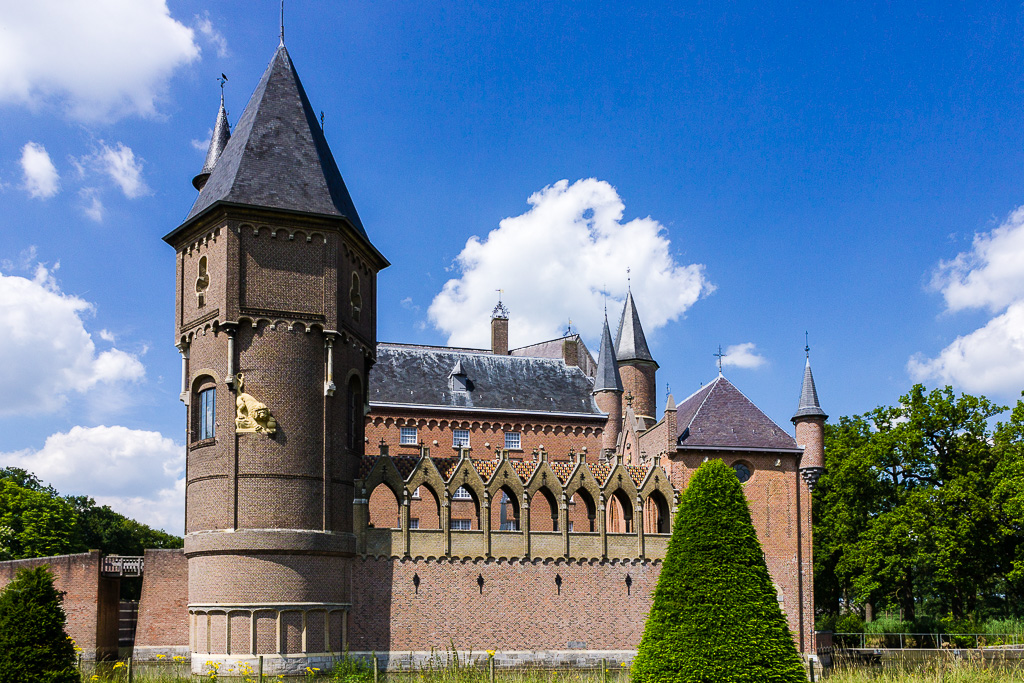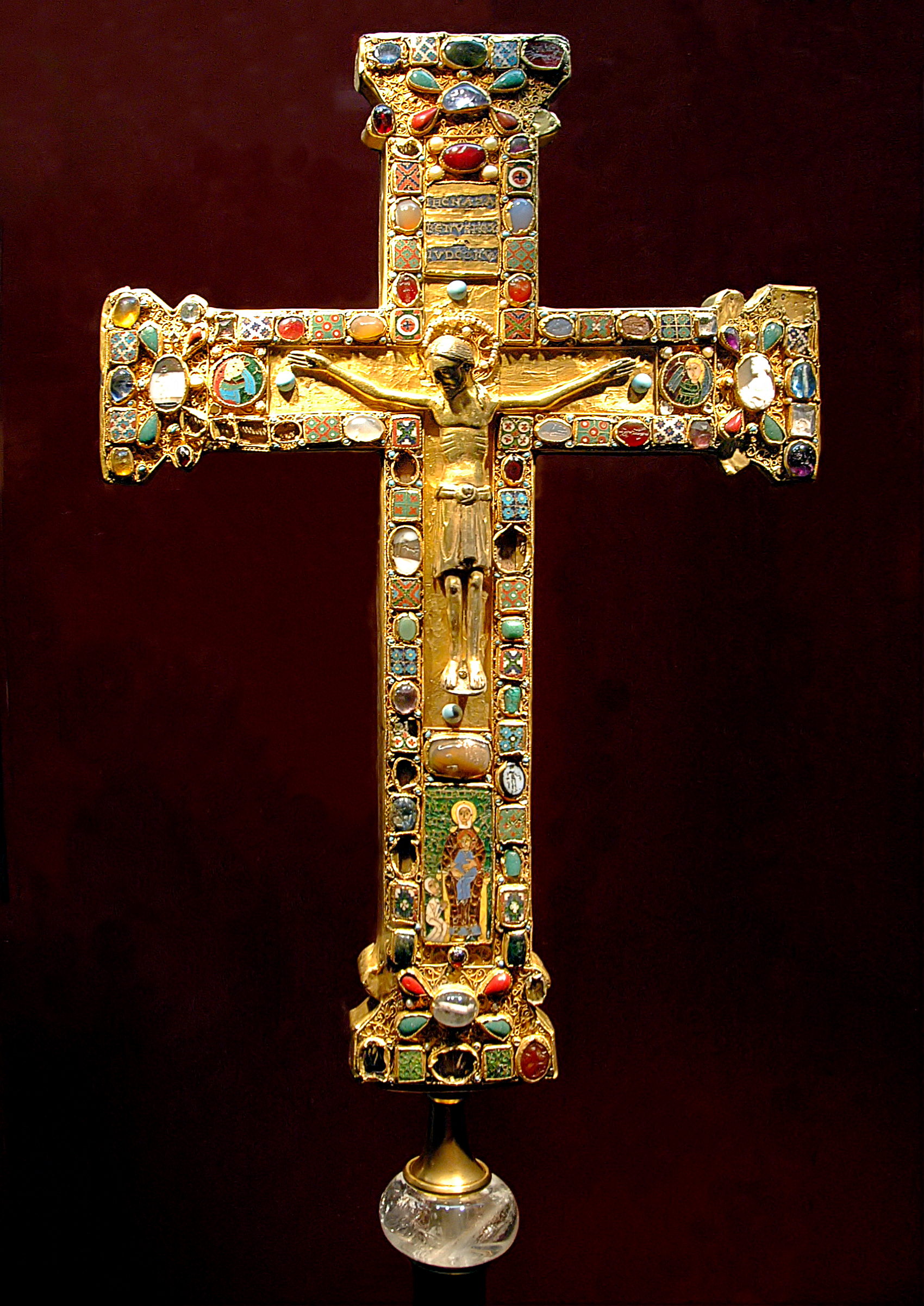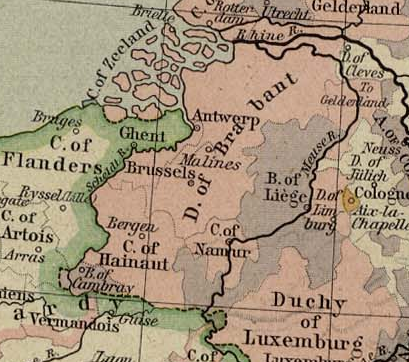|
John I, Duke Of Brabant
John I of Brabant, also called John the Victorious (1252/12533 May 1294) was Duke of Brabant (1267–1294), Lothier and Limburg (1288–1294). During the 13th century, John I was venerated as a folk hero. He has been painted as the perfect model of a brave, adventurous and chivalrous feudal prince. Life Born in Leuven, he was the son of Henry III, Duke of Brabant and Aleidis of Burgundy, daughter of Hugh IV, Duke of Burgundy. He was also an older brother of Maria of Brabant, Queen consort of Philip III of France. In 1267 his older brother Henry IV, Duke of Brabant, being mentally deficient, was deposed in his favour. John's greatest military victory was the Battle of Worringen 1288, by which John I came to reign over the Duchy of Limburg. He was completely outnumbered in forces but led the successful invasion into the Rhineland to defeat the confederacy. In 1288 Limburg was formally attached to Brabant. John I was said to be a model of feudal prince: brave, adventurous; ex ... [...More Info...] [...Related Items...] OR: [Wikipedia] [Google] [Baidu] |
Codex Manesse
The Codex Manesse (also Große Heidelberger Liederhandschrift or Pariser Handschrift) is a ''Liederhandschrift'' (manuscript containing songs), the single most comprehensive source of Middle High German ''Minnesang'' poetry, written and illustrated between c. 1304 when the main part was completed, and c. 1340 with the addenda. The codex was produced in Zürich, for the Manesse family. The manuscript is "the most beautifully illumined German manuscript in centuries"; its 137 miniatures are a series of "portraits" depicting each poet. Contents The Codex Manesse is an anthology of the works of a total of about 135 minnesingers of the mid 12th to early 14th century. For each poet, a portrait is shown, followed by the text of their works. The entries are ordered approximately by the social status of the poets, starting with the Holy Roman Emperor Henry VI, Kings Conradin and Wenceslaus II, down through dukes, counts and knights, to the commoners. Most of the poems are ''Minnesang ... [...More Info...] [...Related Items...] OR: [Wikipedia] [Google] [Baidu] |
Folk Hero
A folk hero or national hero is a type of hero – real, fictional or mythological – with their name, personality and deeds embedded in the popular consciousness of a people, mentioned frequently in folk songs, folk tales and other folklore; and with modern trope status in literature, art and films. Overview Although some folk heroes are historical public figures, many are not. The lives of folk heroes are generally fictional, their characteristics and deeds often exaggerated to mythic proportions. The folk hero often begins life as a normal person, but is transformed into someone extraordinary by significant life events, often in response to social injustice, and sometimes in response to natural disasters. One major category of folk hero is the defender of the common people against the oppression or corruption of the established power structure. Members of this category of folk hero often, but not necessarily, live outside the law in some way. See also * List of fo ... [...More Info...] [...Related Items...] OR: [Wikipedia] [Google] [Baidu] |
Pierre De Bausner
Pierre is a masculine given name. It is a French form of the name Peter. Pierre originally meant "rock" or "stone" in French (derived from the Greek word πέτρος (''petros'') meaning "stone, rock", via Latin "petra"). It is a translation of Aramaic כיפא (''Kefa),'' the nickname Jesus gave to apostle Simon Bar-Jona, referred in English as Saint Peter. Pierre is also found as a surname. People with the given name * Abbé Pierre, Henri Marie Joseph Grouès (1912–2007), French Catholic priest who founded the Emmaus Movement * Monsieur Pierre, Pierre Jean Philippe Zurcher-Margolle (c. 1890–1963), French ballroom dancer and dance teacher * Pierre (footballer), Lucas Pierre Santos Oliveira (born 1982), Brazilian footballer * Pierre, Baron of Beauvau (c. 1380–1453) * Pierre, Duke of Penthièvre (1845–1919) * Pierre, marquis de Fayet (died 1737), French naval commander and Governor General of Saint-Domingue * Prince Pierre, Duke of Valentinois (1895–1964), father ... [...More Info...] [...Related Items...] OR: [Wikipedia] [Google] [Baidu] |
Bar-le-Duc
Bar-le-Duc (), formerly known as Bar, is a commune in the Meuse département, of which it is the capital. The department is in Grand Est in northeastern France. The lower, more modern and busier part of the town extends along a narrow valley, shut in by wooded or vine-clad hills, and is traversed throughout its length by the Ornain, which is crossed by several bridges. It is limited towards the north-east by the Marne–Rhine Canal, on the south-west by a small arm of the Ornain, called the ''Canal des Usines'', on the left bank of which the upper town (''Ville Haute'') is situated. The highly rarefied Bar-le-duc jelly, also known as Lorraine jelly, is a spreadable preparation of white currant or red currant fruit preserves, hailing from this town. First referenced in the historical record in 1344, it is also colloquially referred to as "Bar caviar". History Bar-le-Duc was at one time the seat of the county, from 1354 the Duchy of Bar. Though probably of ancient origin, ... [...More Info...] [...Related Items...] OR: [Wikipedia] [Google] [Baidu] |
North Brabant
North Brabant ( nl, Noord-Brabant ; Brabantian: ; ), also unofficially called Brabant, is a province in the south of the Netherlands. It borders the provinces of South Holland and Gelderland to the north, Limburg to the east, Zeeland to the west, and the Flemish provinces of Antwerp and Limburg to the south. The northern border follows the Meuse westward to its mouth in the Hollands Diep strait, part of the Rhine–Meuse–Scheldt delta. North Brabant has a population of 2,562,566 as of November 2019. Major cities in North Brabant are Eindhoven (pop. 231,642), Tilburg (pop. 217,259), Breda (pop. 183,873) and its provincial capital 's-Hertogenbosch (pop. 154,205). History The Duchy of Brabant was a state of the Holy Roman Empire established in 1183 or 1190. It developed from the Landgraviate of Brabant and formed the heart of the historic Low Countries, part of the Burgundian Netherlands from 1430 and of the Habsburg Netherlands from 1482, until it was spl ... [...More Info...] [...Related Items...] OR: [Wikipedia] [Google] [Baidu] |
Middle Ages
In the history of Europe, the Middle Ages or medieval period lasted approximately from the late 5th to the late 15th centuries, similar to the post-classical period of global history. It began with the fall of the Western Roman Empire and transitioned into the Renaissance and the Age of Discovery. The Middle Ages is the middle period of the three traditional divisions of Western history: classical antiquity, the medieval period, and the modern period. The medieval period is itself subdivided into the Early Early may refer to: History * The beginning or oldest part of a defined historical period, as opposed to middle or late periods, e.g.: ** Early Christianity ** Early modern Europe Places in the United States * Early, Iowa * Early, Texas * Early ..., High Middle Ages, High, and Late Middle Ages. Population decline, counterurbanisation, the collapse of centralized authority, invasions, and mass migrations of tribes, which had begun in late antiquity, continued i ... [...More Info...] [...Related Items...] OR: [Wikipedia] [Google] [Baidu] |
Duchy Of Brabant
The Duchy of Brabant was a State of the Holy Roman Empire established in 1183. It developed from the Landgraviate of Brabant and formed the heart of the historic Low Countries, part of the Burgundian Netherlands from 1430 and of the Habsburg Netherlands from 1482, until it was partitioned after the Dutch revolt. Present-day North Brabant (''Noord-Brabant'') was ceded to the Generality Lands of the Dutch Republic according to the 1648 Peace of Westphalia, while the reduced duchy remained part of the Habsburg Netherlands until it was conquered by French Revolutionary forces in 1794, which was recognized by treaty in 1797. Today all the duchy's former territories, apart from exclaves, are in Belgium except for the Dutch province of North Brabant. Geography The Duchy of Brabant (adjective: '' Brabantian'' or '' Brabantine'') was historically divided into four parts, each with its own capital. The four capitals were Leuven, Brussels, Antwerp and 's-Hertogenbosch. Before ' ... [...More Info...] [...Related Items...] OR: [Wikipedia] [Google] [Baidu] |
Rhineland
The Rhineland (german: Rheinland; french: Rhénanie; nl, Rijnland; ksh, Rhingland; Latinised name: ''Rhenania'') is a loosely defined area of Western Germany along the Rhine, chiefly its middle section. Term Historically, the Rhinelands refers (physically speaking) to a loosely defined region embracing the land on the banks of the Rhine in Central Europe, which were settled by Ripuarian and Salian Franks and became part of Frankish Austrasia. In the High Middle Ages, numerous Imperial States along the river emerged from the former stem duchy of Lotharingia, without developing any common political or cultural identity. A "Rhineland" conceptualization can be traced to the period of the Holy Roman Empire from the sixteenth until the eighteenth centuries when the Empire's Imperial Estates (territories) were grouped into regional districts in charge of defence and judicial execution, known as Imperial Circles. Three of the ten circles through which the Rhine flowed r ... [...More Info...] [...Related Items...] OR: [Wikipedia] [Google] [Baidu] |
Battle Of Worringen
The Battle of Worringen was fought on 5 June 1288 near the town of Worringen (also spelled Woeringen), which is now the northernmost borough of Cologne. It was the decisive battle of the War of the Limburg Succession, fought for the possession of the Duchy of Limburg between on one side the Archbishop Siegfried II of Cologne and Count Henry VI of Luxembourg, and on the other side, Duke John I of Brabant. It was one of the largest battles in Europe in the Middle Ages. Prelude The conflict arose after Duke Waleran IV of Limburg, a scion of the Lotharingian Ardennes-Verdun dynasty, had died without male heirs in 1279. His duchy was inherited by his daughter Ermengarde, who had married Count Reginald I of Guelders about 1270. Her husband claimed the Limburg heritage and in 1282 had his ducal title recognized by the German king Rudolf I. The marriage of Reginald and Ermengarde, however, remained childless and when she died in 1283, Count Adolf VIII of Berg, Duke Waleran's ... [...More Info...] [...Related Items...] OR: [Wikipedia] [Google] [Baidu] |
Philip III Of France
Philip III (1 May 1245 – 5 October 1285), called the Bold (french: le Hardi), was King of France from 1270 until his death in 1285. His father, Louis IX, died in Tunis during the Eighth Crusade. Philip, who was accompanying him, returned to France and was anointed king at Reims in 1271. Philip inherited numerous territorial lands during his reign, the most notable being the County of Toulouse, which was annexed to the royal domain in 1271. With the Treaty of Orléans, he expanded French influence into the Kingdom of Navarre and following the death of his brother Peter during the Sicilian Vespers, the County of Alençon was returned to the crown lands. Following the Sicilian Vespers, Philip led the Aragonese Crusade in support of his uncle. Initially successful, Philip, his army racked with sickness, was forced to retreat and died from dysentery in Perpignan in 1285. He was succeeded by his son Philip IV. Early life Philip was born in Poissy on 1 May 1245, the s ... [...More Info...] [...Related Items...] OR: [Wikipedia] [Google] [Baidu] |
Marie Of Brabant, Queen Of France
Marie of Brabant (13 May 1254 – 12 January 1322) was Queen of France from 1274 until 1285 as the second wife of King Philip III. Born in Leuven, Brabant, she was a daughter of Henry III, Duke of Brabant, and Adelaide of Burgundy. Queen Marie married the widowed Philip III of France on 21 August 1274. His first wife, Isabella of Aragon, had already given birth to three surviving sons: Louis, Philip and Charles. Philip was under the strong influence of his mother, Margaret of Provence, and his minion, surgeon and chamberlain (Chambellan) Pierre de La Broce. Not being French, Marie stood out at the French court. In 1276, Marie's stepson Louis died under suspicious circumstances. Marie was suspected of ordering him to be poisoned. La Brosse, who was also suspected, was imprisoned and later executed for the murder. Queen dowager After the death of Philip III in 1285, Marie lost some of her political influence, and dedicated her life to their three children: Louis (May ... [...More Info...] [...Related Items...] OR: [Wikipedia] [Google] [Baidu] |





